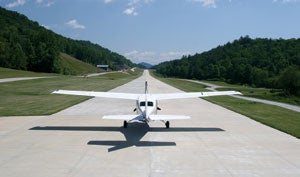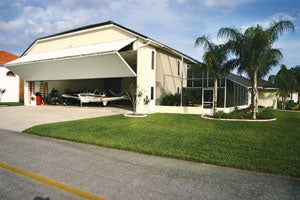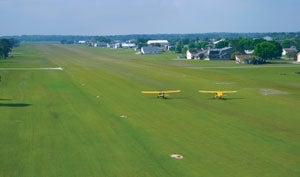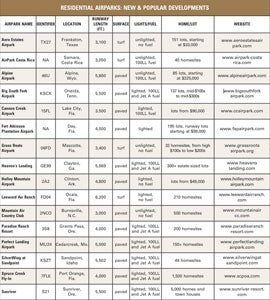 What's an aircraft owner's definition of a "housing crisis"? Owning a home that's too far from the airport. Fortunately, there's never been a better time to develop a rescue plan. The number and variety of residential airparks have grown in recent years, and the slowdown in the economy makes for good deals on airpark lots and homes. But don't expect fire-sale prices; residential airpark property values are reportedly holding up well.
What's an aircraft owner's definition of a "housing crisis"? Owning a home that's too far from the airport. Fortunately, there's never been a better time to develop a rescue plan. The number and variety of residential airparks have grown in recent years, and the slowdown in the economy makes for good deals on airpark lots and homes. But don't expect fire-sale prices; residential airpark property values are reportedly holding up well.
"Knock on wood, we really have not seen any slowdown," says Marc Shubb, marketing director of Perfect Landing Airpark in Cedarcreek, Mo., echoing comments made by developers and real-estate agents nationwide. "We're selling as if there was no recession or depression."
 |
| Mountain Air Country Club in Burnsville, N.C., features 500 homesites nestled atop the Blue Ridge Mountains. |
Dave Sclair, founder of Living With Your Plane (www.livingwithyourplane.com), a residential airpark registry and information clearinghouse, says several factors drive interest in the residential airpark lifestyle. "Number one is security; people want to know who's near their airplane," Sclair says. "The other is purely financial: At a public airport in a metro area, the hangar fee is considerable, and the tiedown fee is considerable too. So why not take that money and put it toward a mortgage and property?"
More than 600 residential airparks are listed in Living With Your Plane's registry, and Sclair estimates that the total number could be closer to 800. Loosely defined as an airport with two or more homes with runway access, residential airparks range from no-frills developments with a turf runway to upscale communities boasting instrument approaches, spas, equestrian facilities, lavish clubhouses and multimillion dollar homes. This means prospective residents have a good chance of finding an airpark perfectly suited to their wants and needs. But the expanded options can increase the workload when it comes to evaluating the choices. Here are key factors to keep in mind when shopping for a residential airpark homesite or house.
Location, Location, Location
Once confined to the Sunbelt, residential airparks are now found in every state except Hawaii and Rhode Island. Consider the area's climate and seasonal changes. You may find that the cool mountain air you enjoy during your summer visits turns unbearably cold in the winter. Or maybe the warmth you found rejuvenating on your last winter trip to Florida becomes oppressively steamy in the summer.
 |
| Heaven's Landing in Clayton, Ga., is located in the Blue Ridge Mountains of northeast Georgia and is surrounded by national forest land. |
Project Runway
The runway is the heart of a residential airpark. Control, ownership and responsibility for maintaining the runway---and access to it---can vary. At some airparks, an owners' association is the controlling authority. At others, the developer retains control; some airparks offer no guarantee for the runway's ongoing existence. Check deed restrictions carefully to ensure the runway and its access have secure futures.
Aviation Services
If you just fly around the patch in VFR conditions and maintain your own airplane, you probably don't need much in the way of on-field support. But if you fly in all conditions, instrument approaches, a fuel farm and a maintenance facility may be critical. Factor these needs into your deliberations.
CC&Rs
The Covenants, Conditions & Restrictions (CC&Rs) document spells out community rules. The covenant covers items that can include minimum size of homes, architectural guidelines and prohibited activities. Prospective buyers need to carefully review and understand the CC&R to avoid unpleasant surprises after purchase.
Beyond Aviation
Believe it or not, there's more to life than aviation. An airpark must provide more than access to the air in order to create a satisfying lifestyle. Fortunately many airparks offer a wealth of activities, either on-site or nearby. But don't just look for an airpark with activities you enjoy: Consider access to shopping, schools and medical facilities.
 |
| Spruce Creek Fly-In in Port Orange, Fla., is America's largest residential airpark. |
Expert Opinion
Talk to residents and get their insights about the community, lifestyle and the positives and negatives of the development. Consult city- or county-planning or zoning officials about the property as well. And use a real-estate agent or attorney familiar with residential airparks to help review and negotiate your property purchase.
Know Before You Go
Obtain all relevant aeronautical information before making a personal visit. Many residential airpark runways can be challenging for pilots used to typical municipal airports. Some may be at high elevations, have relatively short runways or have aircraft without radios in the pattern. Some airparks even recommend getting training from a pilot familiar with the field before flying in.
The Search
With the preceding caveats in mind, you're ready to start the fun part---reviewing choices and imagining yourself living alongside your airplane. Quick access to your airplane is just one of the attractions of today's residential airparks. Heaven's Landing, for example, in northern Georgia, has a community clubhouse, racquetball and tennis courts (plus an on-site sauna and Jacuzzi), and is surrounded by a national forest, which provides more recreational opportunities.
"We have a great lifestyle," said developer Mike Ciochetti, ticking off available activities. "White-water rafting, power boating, trout fishing, hunting, golfing, cycling and motorcycling, and we're three miles from the county seat."
 |
| Leeward Air Ranch in Ocala, Fla., attracts warbird and vintage aircraft fans. |
Mountain Air Country Club in Burnsville, N.C., featuring the highest runway east of the Mississippi (4,400 feet), set the tone for upscale airparks with complete outdoor activities when it was founded in 1990. Nestled in the Blue Ridge Mountains, homes in this upscale community range from $500,000 to $3 million.
"New homes are still going up," said Mountain Air President Randy Banks, whose father and uncle established the airpark. "We're still in the expansion and development mode."
Several new developments, including Big South Fork Airpark in Tennessee, offer equestrian centers as well as aviation facilities. "’Active outdoor' would be the way I describe [the typical buyer/resident]," said developer Bill Armstrong. "Folks who choose this are into planes and equestrian things. They're not coming up to go shopping at Macy's."
Perfect Landing Airpark also features an equestrian center, though its setting on Bull Shoals Lake also provides access to water sports. Currently under development, Perfect Landing will also have a biometric security system and 24-hour concierge services. "It's a very upscale development," said Shubb, the marketing director.
A few residential airparks have "through the fence" access arrangements with adjacent municipal airports. This relieves residents of concerns about the preservation and maintenance of the runway. Silverwing at Sandpoint in Sandpoint, Idaho, is the newest of such developments.
"This is going to be an aviator's dream," said John McKeown, one of the owners. "It's 10 minutes to one of the best ski resorts in the Pacific Northwest, there are backcountry strips everywhere, there's hunting and fishing, and Sandpoint is one of best small towns in America."
The aviation lifestyle has even spread internationally. Airpark Costa Rica on Costa Rica's Pacific coast offers beautiful beaches, fishing, scuba diving, golf and the country's famed jungles and national parks.
"It's a small community for people who like flying and nature," said Pieter Monsma, the airpark's president, who happens to be from Holland. Monsma bought the property a couple of years ago but didn't know what to do with it until he saw an episode of CSI on TV. "The police guys came into the house to arrest a woman and she taxied out of the garage in her airplane and took off. Before that, I never saw that that was possible," Monsma said. "Now, we're ready to rock 'n' roll."

Subscribe to Our Newsletter
Get the latest Plane & Pilot Magazine stories delivered directly to your inbox







